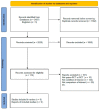Efficacy of Hip Strengthening on Pain Intensity, Disability, and Strength in Musculoskeletal Conditions of the Trunk and Lower Limbs: A Systematic Review with Meta-Analysis and Grade Recommendations
- PMID: 36552918
- PMCID: PMC9776732
- DOI: 10.3390/diagnostics12122910
Efficacy of Hip Strengthening on Pain Intensity, Disability, and Strength in Musculoskeletal Conditions of the Trunk and Lower Limbs: A Systematic Review with Meta-Analysis and Grade Recommendations
Abstract
To investigate the efficacy of hip strengthening on pain, disability, and hip abductor strength in musculoskeletal conditions of the trunk and lower limbs, we searched eight databases for randomized controlled trials up to 8 March 2022 with no date or language restrictions. Random-effect models estimated mean differences (MDs) with 95% confidence intervals (CIs), and the quality of evidence was assessed using the GRADE approach. Very low quality evidence suggested short-term effects (≤3 months) of hip strengthening on pain intensity (MD of 4.1, 95% CI: 2.1 to 6.2; two trials, n = 48 participants) and on hip strength (MD = 3.9 N, 95% CI: 2.8 to 5.1; two trials, n = 48 participants) in patellofemoral pain when compared with no intervention. Uncertain evidence suggested that hip strengthening enhances the short-term effect of the other active interventions on pain intensity and disability in low back pain (MD = -0.6 points, 95% CI: 0.1 to 1.2; five trials, n = 349 participants; MD = 6.2 points, 95% CI: 2.6 to 9.8; six trials, n = 389 participants, respectively). Scarce evidence does not provide reliable evidence of the efficacy of hip strengthening in musculoskeletal conditions of the trunk and lower limbs.
Keywords: disability; hip strength; hip strengthening; musculoskeletal conditions; pain intensity; rehabilitation.
Conflict of interest statement
The authors declare no conflict of interest.
Figures




References
-
- Pareja-Blanco F., Alcazar J., Cornejo-Daza P.J., Sánchez-Valdepeñas J., Rodriguez-Lopez C., Hidalgo-de Mora J., Sánchez-Moreno M., Bachero-Mena B., Alegre L.M., Ortega-Becerra M. Effects of velocity loss in the bench press exercise on strength gains, neuromuscular adaptations, and muscle hypertrophy. Scand. J. Med. Sci. Sports. 2020;30:2154–2166. doi: 10.1111/sms.13775. - DOI - PubMed
LinkOut - more resources
Full Text Sources
Research Materials
Miscellaneous

